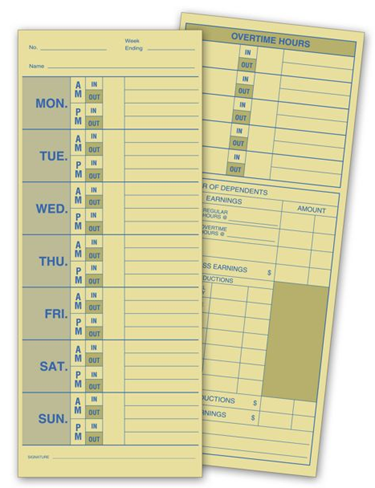Section 1-3: Weekly Time Card
Section 1-3: Weekly Time Card
Overview


To calculate the total hours on a weekly time card, you need to sum up the number of hours worked each day for the entire week. Here's how you can do it:
Record Hours Worked Each Day: Start by recording the number of hours worked by the employee each day of the week. This includes both regular hours and any overtime hours worked.
Add Up Daily Hours: Add together the hours worked each day to get the total hours worked for the week.
Let's illustrate this with an example:
Suppose an employee's time card for a week looks like this:
- Monday: 8 hours
- Tuesday: 8 hours
- Wednesday: 8 hours
- Thursday: 9 hours
- Friday: 7 hours
To calculate the total hours worked for the week:
Total Hours = 8 hours (Monday) + 8 hours (Tuesday) + 8 hours (Wednesday) + 9 hours (Thursday) + 7 hours (Friday) = 40 hours
Therefore, the total hours worked on the weekly time card would be 40 hours.
Online Textbook Read Section 1-3: (Calculate Weekly Time Card)
What is a Weekly Time Card?
Overview

 A weekly time card is a document used by employers to track the hours worked by employees over the course of a week. It typically includes columns or sections where employees record their daily start and end times for each workday, as well as any breaks or meal periods taken.
A weekly time card is a document used by employers to track the hours worked by employees over the course of a week. It typically includes columns or sections where employees record their daily start and end times for each workday, as well as any breaks or meal periods taken.
Key components of a weekly time card may include:
Employee Information: This includes the employee's name, employee ID or number, department, and possibly other identifying information.
Week Starting Date: The time card will specify the week for which the hours are being recorded, usually starting with the first day of the workweek.
Daily Hours: Employees record their start and end times for each workday. Some time cards may also include separate columns for recording break times or meal periods.
Total Hours: The total number of hours worked each day and for the entire week are typically calculated and recorded on the time card.
Overtime Hours: If applicable, overtime hours (hours worked beyond a certain threshold, usually 40 hours in a workweek) may be indicated separately.
Employee Signature/Approval: Once the week's hours are recorded, the employee may need to sign or otherwise approve the time card to confirm its accuracy.
Supervisor/Manager Approval: A supervisor or manager may review and approve the time card to ensure accuracy and compliance with company policies and labor laws.
Weekly time cards serve as a record of hours worked by employees, which is used for various purposes such as calculating payroll, determining eligibility for overtime pay, and tracking attendance. They are a common tool used in many workplaces, particularly those with hourly or non-exempt employees who are paid based on the hours they work. Additionally, they help ensure accurate and transparent record-keeping for both employees and employers.
Absolutely, let's structure a lesson on weekly time cards:
Objective: Understand the purpose and components of a weekly time card.
Definition: A weekly time card is a document used by employers to track the hours worked by employees over the course of a week. It serves as a record of attendance and hours worked, aiding in payroll processing and compliance with labor laws.
Key Components:
Employee Information: The time card typically includes fields for the employee's name, employee ID or number, department, and possibly other identifying details.
Week Starting Date: The time card specifies the start date of the week being recorded, usually corresponding to the company's defined workweek.
Daily Hours: Employees record their daily start and end times for each workday on the time card. This may also include spaces for recording breaks or meal periods taken during the shift.
Total Hours: The total number of hours worked each day and for the entire week are calculated and recorded on the time card. This total is crucial for determining the employee's compensation.
Overtime Hours: If applicable, overtime hours worked beyond a certain threshold (typically 40 hours in a workweek) are indicated separately on the time card. This helps in identifying when overtime pay is owed to employees.
Employee Signature/Approval: Once the week's hours are recorded, the employee may be required to sign or otherwise approve the time card to verify its accuracy. This confirms that the hours recorded are correct.
Supervisor/Manager Approval: A supervisor or manager reviews the time card to ensure accuracy and compliance with company policies and labor laws. Their approval signifies that the time card has been reviewed and accepted.
Example Scenario:
Let's say John works Monday through Friday from 9:00 AM to 5:00 PM with a one-hour lunch break. Here's how his time card might look:
- Employee Name: John Doe
- Employee ID: 123456
- Department: Sales
- Week Starting Date: Monday, March 18, 2024
- Daily Hours:
- Monday: 9:00 AM - 5:00 PM (8 hours)
- Tuesday: 9:00 AM - 5:00 PM (8 hours)
- Wednesday: 9:00 AM - 5:00 PM (8 hours)
- Thursday: 9:00 AM - 5:00 PM (8 hours)
- Friday: 9:00 AM - 5:00 PM (8 hours)
- Total Hours: 40 hours
- Employee Signature: [John's signature]
- Manager Approval: [Manager's signature]
Conclusion: Weekly time cards are essential tools for tracking employee attendance and hours worked. They provide a systematic way to record and verify work hours, ensuring accurate payroll processing and compliance with labor regulations. Understanding how to complete and review time cards is crucial for both employees and employers to maintain transparency and fairness in the workplace.
